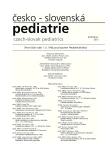Increase of pollinosis among school youth in town and in countryside in recent 20 years (1988–2009)
Authors:
D. Tilandyová 1; M. Helbich 2; L. Koller 3
Authors‘ workplace:
Detská alergologická ambulancia, Poliklinika, s. r. o., Trenčín, Caldera s. r. o., Bratislava , GSK Slovakia s. r. o., Bratislava
1
Published in:
Čes-slov Pediat 2012; 67 (1): 27-32.
Category:
Original Papers
Overview
Prevalence of allergic diseases increased greatly in recent decades, especially in children. The most frequent allergic disease in school age is seasonal allergic rhinitis caused by pollen – pollinosis.
Objective:
The aim of this study was to obtain the actual epidemiologic data of pollen allergy prevalence and to compare them with the results of epidemiologic survey from 1988.
Methods:
From December 2008 till February 2009 we had examined primary school pupils in the town and in the countryside (total number of pupils 1017), where the survey was performed also 20 years ago. Questionnaires with questions about allergic diseases, respiratory infects, ORL operations and those about demographic data were given to parents,. We collected 602 evaluable questionnaires, 495 children were prick-tested for pollen allergen Grass mixture 5. 135 children, who had positive allergic reaction, underwent complete allergological examination. Presence of allergy is assessed based on positivity of prick test. Latent allergy is considered when parents have not reported any clinical signs of allergy (rhinitis, skin disorders, food intolerance, etc.), but skin prick test is positive.
Results:
In the town-school, the presence of pollen allergy was found in 23.3% of children (95% CI=17.6–28.9%), from which 5.6% is in latent form (positive skin tests, negative clinical manifestations). In the village-school, the prevalence of pollen allergy was 15.5% (95% CI=11.0–19.9%), from which 4.8% is in latent form). For comparison – the results from 1988 were: prevalence in town was 11.8% (3.4% latent form) and in countryside it was 4.8% (2.2% latent form). Observed increase is statistically significant p<0.01.
The most frequent manifestation was allergic rhinitis - 34.2% (95% CI=31.5–36.9%) among all children. The prevalence was not significantly higher in boys compared to girls in rate of 1.3:1 (p=0.11). Up to 50% of children reported at least 1 allergic manifestation.
The prevalence of allergic rhinitis was higher in the town (p=0.013), in children of parents with higher education (education of mother p=0.057, education of father p=0.002) and with positive history of allergic diseases in parents or siblings (p<0.001).
Conclusion:
Comparing the results from 1988 and 2008/2009 we discovered, that the prevalence of pollinosis in the town has doubled and in the countryside even trebled in recent 20 years.
Key words:
pollinosis, school age, town, countryside
Sources
1. Kverka M, Malý M, Dlouhý P, Kučera P. Hodnocení rizikových faktorů alergických onemocnění v populaci pražských dětí. Alergie 2003; 5 (3): 179–183.
2. Hrubiško M, Paulovičová E. Alergická a peľom indukovaná astma. Klin Imunol Alergol 2003; 13 (4): 11–17.
3. Gold M, et al. The Complette Kid’s Alergy and Asthma. Guide. Canada, Toronto: 2003.
4. Tilandyová D, Uhlárová M, Sámel L, Muchová M. Výskyt polinózy u školskej mládeže v meste a na vidieku. Čes-slov Pediat 1989; 44 (8): 459–462.
5. Supplement to The Journal of Allergy and Clinical Immunology, vol. 108, No. 5, November 2001.
6. Weiland SK, Bjorksten B, Brunekreef B, Cookson WOC, von Mutius E, Strachan DP, and the International study of Asthma and Allergies in Childhood Phase II Study Group. Phase II of the International Study of Asthma and Allergies in Childhood (ISAAC II): rationale and methods. Eur Respir J 2004; 24: 406–412.
7. Asher M, Montefort S, Bjorksten B, Strachan D, Weiland SK, Williams H. Worldwide time trends in the prevalence of symptoms of asthma, allergic rhinoconjunctivitis, and eczema in childhood: ISAAC Phases One and Three repeat multicountry cross – sectional surveys. Lancet 2006; 368: 733–743.
8. Fact sheet N. 3. 1. Prevalence of asthma and allergies in children. WHO Regional Office for Europe. Copenhagen: 2007.
9. Swatee P Patel, Järvelin Marjo-Riitta, Little P Mark. Systematic review of worldwide variations of the prevalence of wheezing symptoms in children. Enviromental Health 2008.7.57. http: www.ehjournal.net/content/7/I/57.
10. Výskyt astmatu a alergií u dětí, 12. květen 2008, www.szu.cz/Home Témata zdraví a bezpečnosti, Hygiena životního prostředí, Indikátory zdraví a životního prostředí, Vnitřní prostředí.
11. Systém monitorování zdravotního stavu obyvatelstva ČR ve vztahu k životnímu prostředí. 3. Alergie. www.szu.cz/ uploads//alergie_08.pdf
12. Hlavatá A, Čižnár P, Palkovičová Ľ, Rausová K, Ursínyová M, Hlavatý T, Reichrtová E, Benedeková M, Červeňová O. Výskyt a rizikové faktory alergických ochorení u detí predškolského veku v priemyselnom a vidieckom regióne Slovenska. Čes-slov Pediat 2008; 63 (12): 668–676.
13. Tihányi J. Výskyt alergických ochorení u 5-ročných detí vo vzťahu k environmentálnym faktorom v 8 regiónoch Slovenska s rozdielnym typom znečistenia. old.szu.sk/ine//2006_l/tihanyi_06.
Labels
Neonatology Paediatrics General practitioner for children and adolescentsArticle was published in
Czech-Slovak Pediatrics

2012 Issue 1
- What Effect Can Be Expected from Limosilactobacillus reuteri in Mucositis and Peri-Implantitis?
- The Importance of Limosilactobacillus reuteri in Administration to Diabetics with Gingivitis
Most read in this issue
- When to search for inhereted thrombophilia risk factors in children?
- Influenced pain by children dental treatment
- The effect of thumb sucking on splanchocraniums development in childhood
- Thymidin kinase – suitable marker for diagnostics and follow up in childhood leukemia
